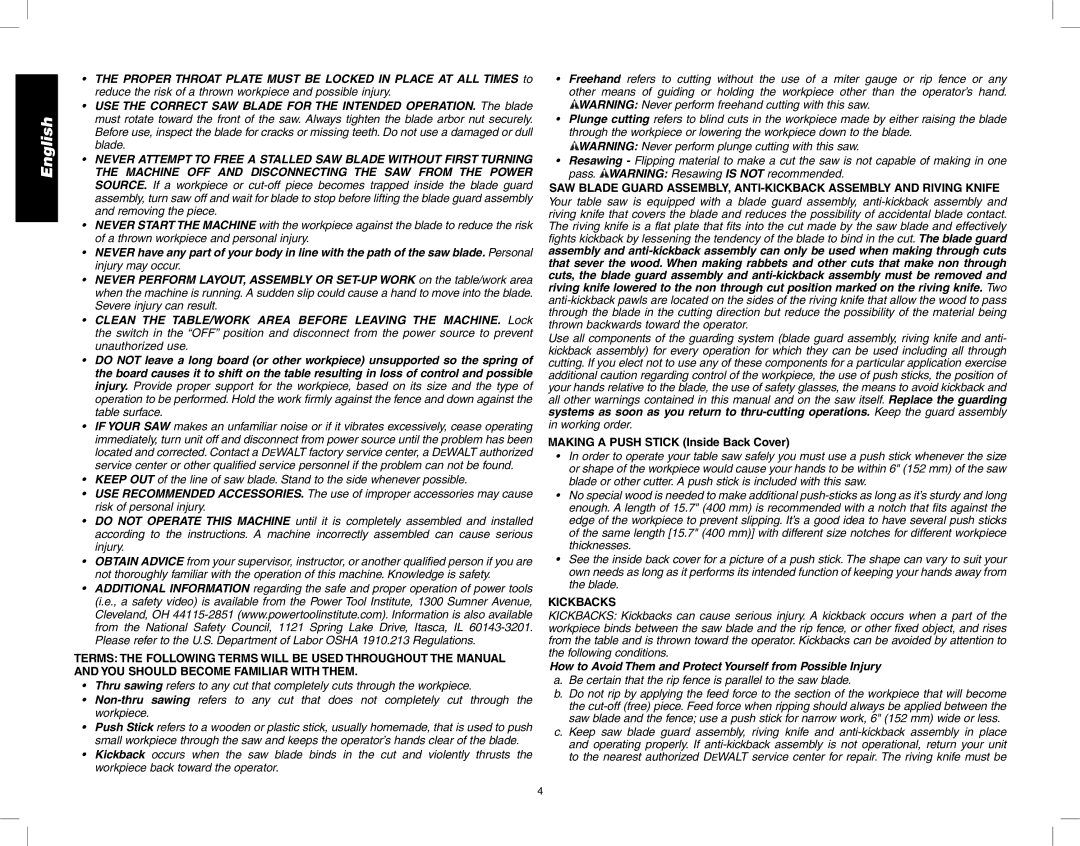
English
•THE PROPER THROAT PLATE MUST BE LOCKED IN PLACE AT ALL TIMES to reduce the risk of a thrown workpiece and possible injury.
•USE THE CORRECT SAW BLADE FOR THE INTENDED OPERATION. The blade must rotate toward the front of the saw. Always tighten the blade arbor nut securely. Before use, inspect the blade for cracks or missing teeth. Do not use a damaged or dull blade.
•NEVER ATTEMPT TO FREE A STALLED SAW BLADE WITHOUT FIRST TURNING THE MACHINE OFF AND DISCONNECTING THE SAW FROM THE POWER SOURCE. If a workpiece or
•NEVER START THE MACHINE with the workpiece against the blade to reduce the risk of a thrown workpiece and personal injury.
•NEVER have any part of your body in line with the path of the saw blade. Personal injury may occur.
•NEVER PERFORM LAYOUT, ASSEMBLY OR
•CLEAN THE TABLE/WORK AREA BEFORE LEAVING THE MACHINE. Lock the switch in the “OFF” position and disconnect from the power source to prevent unauthorized use.
•DO NOT leave a long board (or other workpiece) unsupported so the spring of the board causes it to shift on the table resulting in loss of control and possible injury. Provide proper support for the workpiece, based on its size and the type of operation to be performed. Hold the work firmly against the fence and down against the table surface.
•IF YOUR SAW makes an unfamiliar noise or if it vibrates excessively, cease operating immediately, turn unit off and disconnect from power source until the problem has been located and corrected. Contact a DEWALT factory service center, a DEWALT authorized service center or other qualified service personnel if the problem can not be found.
•KEEP OUT of the line of saw blade. Stand to the side whenever possible.
•USE RECOMMENDED ACCESSORIES. The use of improper accessories may cause risk of personal injury.
•DO NOT OPERATE THIS MACHINE until it is completely assembled and installed according to the instructions. A machine incorrectly assembled can cause serious injury.
•OBTAIN ADVICE from your supervisor, instructor, or another qualified person if you are not thoroughly familiar with the operation of this machine. Knowledge is safety.
•ADDITIONAL INFORMATION regarding the safe and proper operation of power tools (i.e., a safety video) is available from the Power Tool Institute, 1300 Sumner Avenue, Cleveland, OH
TERMS: THE FOLLOWING TERMS WILL BE USED THROUGHOUT THE MANUAL AND YOU SHOULD BECOME FAMILIAR WITH THEM.
•Thru sawing refers to any cut that completely cuts through the workpiece.
•
•Push Stick refers to a wooden or plastic stick, usually homemade, that is used to push small workpiece through the saw and keeps the operator’s hands clear of the blade.
•Kickback occurs when the saw blade binds in the cut and violently thrusts the workpiece back toward the operator.
•Freehand refers to cutting without the use of a miter gauge or rip fence or any other means of guiding or holding the workpiece other than the operator’s hand. ![]() WARNING: Never perform freehand cutting with this saw.
WARNING: Never perform freehand cutting with this saw.
•Plunge cutting refers to blind cuts in the workpiece made by either raising the blade through the workpiece or lowering the workpiece down to the blade.
![]() WARNING: Never perform plunge cutting with this saw.
WARNING: Never perform plunge cutting with this saw.
•Resawing - Flipping material to make a cut the saw is not capable of making in one pass. ![]() WARNING: Resawing IS NOT recommended.
WARNING: Resawing IS NOT recommended.
SAW BLADE GUARD ASSEMBLY,
Your table saw is equipped with a blade guard assembly,
Use all components of the guarding system (blade guard assembly, riving knife and anti- kickback assembly) for every operation for which they can be used including all through cutting. If you elect not to use any of these components for a particular application exercise additional caution regarding control of the workpiece, the use of push sticks, the position of your hands relative to the blade, the use of safety glasses, the means to avoid kickback and all other warnings contained in this manual and on the saw itself. Replace the guarding systems as soon as you return to
MAKING A PUSH STICK (Inside Back Cover)
•In order to operate your table saw safely you must use a push stick whenever the size or shape of the workpiece would cause your hands to be within 6" (152 mm) of the saw blade or other cutter. A push stick is included with this saw.
•No special wood is needed to make additional
•See the inside back cover for a picture of a push stick. The shape can vary to suit your own needs as long as it performs its intended function of keeping your hands away from the blade.
KICKBACKS
KICKBACKS: Kickbacks can cause serious injury. A kickback occurs when a part of the workpiece binds between the saw blade and the rip fence, or other fixed object, and rises from the table and is thrown toward the operator. Kickbacks can be avoided by attention to the following conditions.
How to Avoid Them and Protect Yourself from Possible Injury
a.Be certain that the rip fence is parallel to the saw blade.
b.Do not rip by applying the feed force to the section of the workpiece that will become the
c.Keep saw blade guard assembly, riving knife and
4
